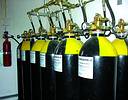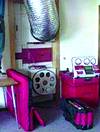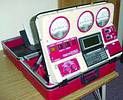

Many years ago when fixed extinguishing systems consisted only of Halon 1301 and CO2, and fixed system standards were in their infancy, full discharge testing was considered mandatory.
However, the 1996 edition of the NFPA 2001 standard went as far as to state, "a discharge test is generally not recommended". In addition room integrity testing was introduced to replace discharge testing. Why is full scale discharge testing now frowned upon around the world and why is room integrity testing a mandatory requirement of SABS and ISO codes?

Why discharge test?
Initially, discharge testing was performed to test the reliability of the electrical and mechanical fire extinguishing system and to validate the extinguishing concentrations. As the installation and equipment manufacturing standards became more stringent and the move towards the implementation of quality management systems became the norm rather than the exception it was found that the mechanical and electrical reliability of systems began improving. Statistical measurement techniques as required by ISO 9000 highlighted manufacturing problem areas sufficiently to implement timeous corrective actions should problems occur.
One should also understand that comprehensive system testing prior to the issue of a full system approval at both extremes of the system design parameters validates the performance range of the equipment offered.
It should also be noted that a system discharge test may only verify the design for that particular system configuration at that particular point in time. The validation of performance criteria is established by the system approval certificate, which is issued by independent third parties (at arms length) after rigorous testing and if process manufacturing controls have been implemented by the manufacturers.
When performing a discharge test one only has seconds to establish where any problem may occur if the design concentration is not reached. Also, should the design concentrations not be reached then further expensive discharge testing will be required.
With the concerns over the depletion of the ozone layer, discharge testing of Halon systems was curtailed. As a result, a new method of testing had to be found; that method of testing is enclosure integrity acceptance testing.

Understanding extinguishing concentration
All gas system design standards require a certain design concentration of extinguishant be achieved in a pre-defined time. What many people fail to grasp is that this concentration must be maintained for a minimum time period (generally 10 minutes for clean agents). To complicate matters two primary types of mixing occur during and after a gas discharge:-
* Descending interface.
* Continuous mixing.
During the discharge, and providing the system has been correctly designed, there will be continuous mixing. After the discharge the mixing model will depend on the status of the airconditioning system.
These factors affect the extinguishing concentration profile.
What is room integrity testing?
Room integrity testing is a mandatory requirement of the gas extinguishing standard SABS/ISO 14520. In addition the standard states that the testing must be carried out every 12 months to validate the enclosure integrity. Failure to perform this annual testing, places the system performance responsibilities clearly on the shoulders of the end user.
Failure to perform the initial room integrity test is also a violation of the SABS design and installation code and places the system performance responsibilities clearly on the shoulders of the installation contractor.
The test consists of pressurising the enclosure with calibrated fans that provide specific airflows at specific flow pressures. In addition, the exterior and interior pressures of the enclosure are monitored so as to determine the air leakage of the room.
The earlier NFPA 2001 standard only requires a single measurement to be performed, while the SABS/ISO standard requires multiple sets of test data to be recorded. The SABS/ISO requirement is therefore more accurate and can highlight equipment errors and prevents operator 'fudging' of the results, since the minimum correlation factor and allowable standard deviation is specified.
The test result is provided as an equivalent leakage area (ELA) in square metres. This ELA is the sum total of leakage paths in the room.
By utilising a computer model of the gas extinguishing agent properties and knowing the ELA, the gas extinguishing retention times for the minimum design concentration can be determined.
If the retention time is greater than 10 minutes then the room passes, if the retention time is less than 10 minutes then the room fails.
If a room fails it is easy to locate the leakage paths using smoke pencils and seal the leaks. It should be noted that enclosure integrity and the fire resistance thereof is also a requirement of BS 6266, this standard is implicitly referred to in BS 5839 which has also been adopted in South Africa as SABS 0139.
Why perform room integrity testing?
1. Room integrity testing is a mandatory requirement of the SABS/ISO clean agent standard. This applies to all gasses and all systems. There are no exceptions.
2. Although not mandatory it is highly recommended that room integrity be performed on CO2 installations. CO2 has one of the highest densities of any extinguishing gas and so has one of the highest column pressures. This means that it is one of the most difficult gasses to maintain at the correct concentration - and the retention times are typically 20 minutes - ie twice as long as the clean agents (see Table 1).

3. Extinguishing concentration measurements in a discharge test generally overestimate the actual extinguishing concentration by a substantial margin. The results can easily mislead one into a false sense of security.
4. Room integrity testing allows the total room leakage to be identified and if this leakage is too great remedial action can be taken immediately and the results of the remedial work checked.
5. One of the most important design aspects of all clean agent systems is correct room venting. This is also especially true of CO2 systems. High discharge rates (10 s) of the chemical synthetic gasses and high air displacement of the inerts (±40%) make venting a key issue. Too little venting and the room can be subjected to overpressurisation, which will result in structural failure. Too much venting and the gas extinguishing concentration may not be achieved for the prescribed time period. Room integrity testing allows the venting requirements to be verified by on-site testing.
6. Major savings to air conditioner running costs.
For more information contact Paul Wright, Alien Systems and Technologies, 011 949 1157.

© Technews Publishing (Pty) Ltd. | All Rights Reserved.